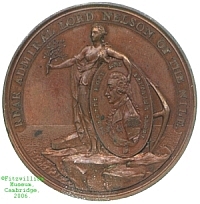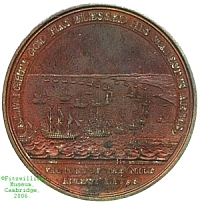Davison's Nile Medal, issued 1798

Obverse, Pax with olive branch standing left on shoreline outcrop, with shield under left arm bearing bust of Nelson and legend: "EUROPE'S HOPE AND ENGLAND'S GLORY"
|

Reverse, Fleet off shore with rising sun in background; exergue inscription reads: "Victory of the Nile / August 1, 1798"
|
<- Previous | Next ->
Back to gallery page
Davison's Nile Medal, 1798 (French Revolutionary War)
One of then-General Napoleon Bonaparte's earlier plans against the British Empire during the French Revolutionary Wars was to threaten India by the capture of Egypt, and to attempt to open a canal between the Mediterranean and the Red Sea. A French expedition arrived in the country in 1798, and British forces were sent in pursuit under Rear-Admiral Horatio Nelson.
The fleets met in Aboukir Bay on the night of 1 August 1798, and Nelson was able to approach from windward so that French ships to the lee could not sail up to support their fellows. As a result Nelson was able to demolish the French line ship by ship, and the French fleet was almost entirely sunk or captured with only 218 casualties on the British side. The victory secured Nelson's reputation, but also led to Bonaparte's return to France to stage the coup that made him First Consul.
Nelson's victory was greatly celebrated in Britain, and although no official medal was issued for the action until 1848 (by which time very few potential claimants were still alive), Nelson's prize agent for the campaign, Alexander Davison, had this medal made in Birmingham at his own expense for distribution to the officers and men present at the battle.
Captains and above received gold, other officers silver, but this example in bronze would have been awarded to a rating. It remains unnamed as issued and so the recipient is unknown. Lester Watson acquired the medal at some point before 1928.

